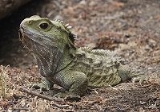
Sauria
Encyclopedia
Sauria is a clade
of reptiles that includes all living diapsid
s, as well as their common ancestor and all its extinct descendants. The ancestral saurian was probably a small lizard-like creature living in the Permian
Period. This crown group
is diagnosed by a number of details in skull and skeleton, and comprises the two important clades Lepidosauromorpha
and Archosauromorpha
.
The term "Sauria" has previously been used as a synonym of Lacertilia, a suborder of Squamata
that includes all lizards but excludes snakes. This classification is rarely used today because Sauria so-defined is a paraphyletic group.
Clade
A clade is a group consisting of a species and all its descendants. In the terms of biological systematics, a clade is a single "branch" on the "tree of life". The idea that such a "natural group" of organisms should be grouped together and given a taxonomic name is central to biological...
of reptiles that includes all living diapsid
Diapsid
Diapsids are a group of reptiles that developed two holes in each side of their skulls, about 300 million years ago during the late Carboniferous period. Living diapsids are extremely diverse, and include all crocodiles, lizards, snakes, and tuatara...
s, as well as their common ancestor and all its extinct descendants. The ancestral saurian was probably a small lizard-like creature living in the Permian
Permian
The PermianThe term "Permian" was introduced into geology in 1841 by Sir Sir R. I. Murchison, president of the Geological Society of London, who identified typical strata in extensive Russian explorations undertaken with Edouard de Verneuil; Murchison asserted in 1841 that he named his "Permian...
Period. This crown group
Crown group
A crown group is a group consisting of living representatives, their ancestors back to the most recent common ancestor of that group, and all of that ancestor's descendants. The name was given by Willi Hennig, the formulator of phylogenetic systematics, as a way of classifying living organisms...
is diagnosed by a number of details in skull and skeleton, and comprises the two important clades Lepidosauromorpha
Lepidosauromorpha
Lepidosauromorpha is a group of reptiles comprising all diapsids closer to lizards than to archosaurs . The only living sub-group is the Lepidosauria: extant lizards, snakes, and tuatara...
and Archosauromorpha
Archosauromorpha
Archosauromorpha is an infraclass of diapsid reptiles that first appeared during the late Permian and became more common during the Triassic. Included in this infraclass are the groups Rhynchosauria, Trilophosauridae, Prolacertiformes, Archosauriformes, and, tentatively, Choristodera...
.
The term "Sauria" has previously been used as a synonym of Lacertilia, a suborder of Squamata
Squamata
Squamata, or the scaled reptiles, is the largest recent order of reptiles, including lizards and snakes. Members of the order are distinguished by their skins, which bear horny scales or shields. They also possess movable quadrate bones, making it possible to move the upper jaw relative to the...
that includes all lizards but excludes snakes. This classification is rarely used today because Sauria so-defined is a paraphyletic group.
External links
- Sauria cladogram

